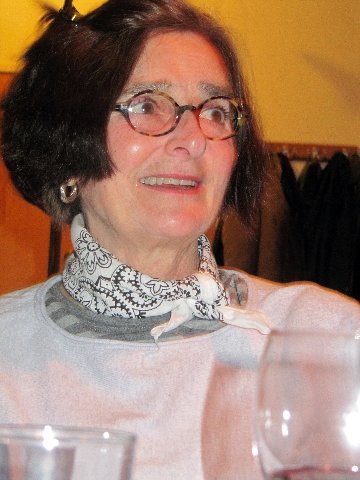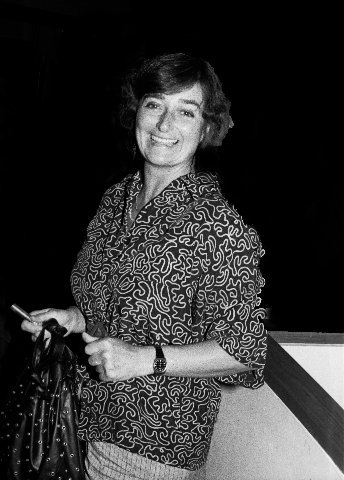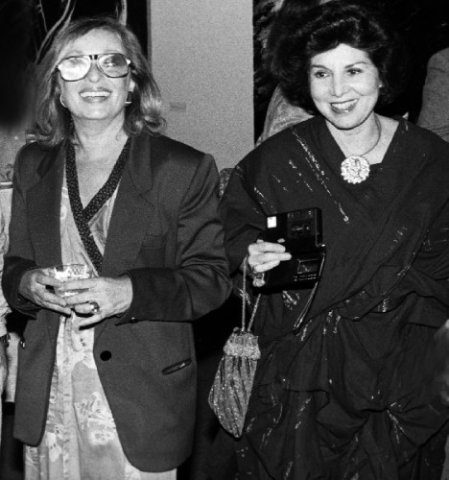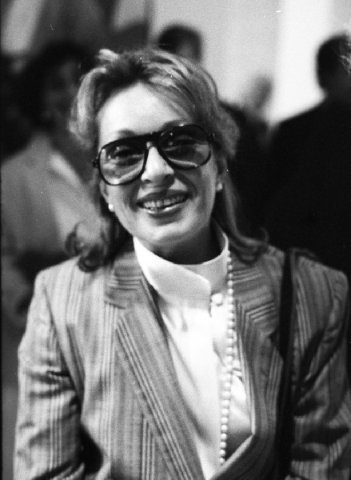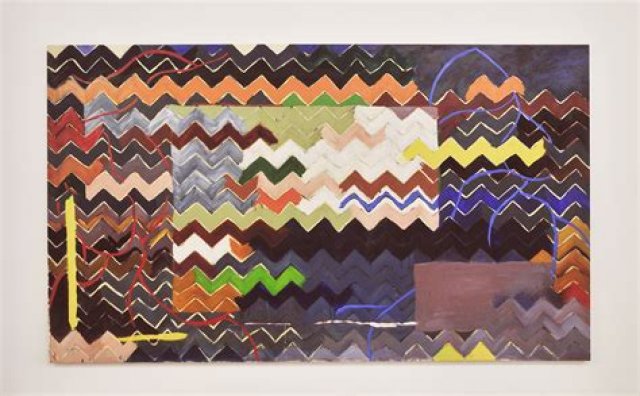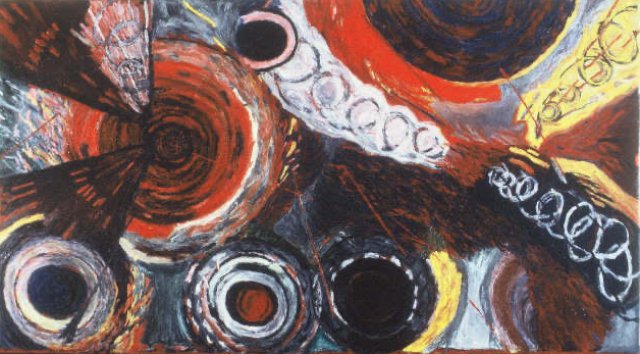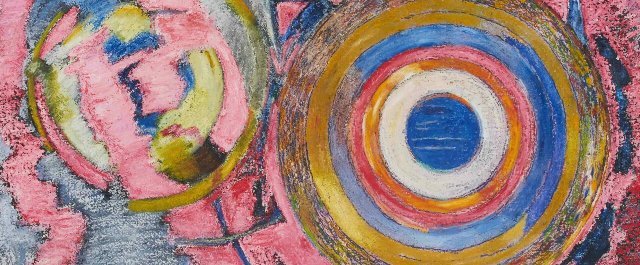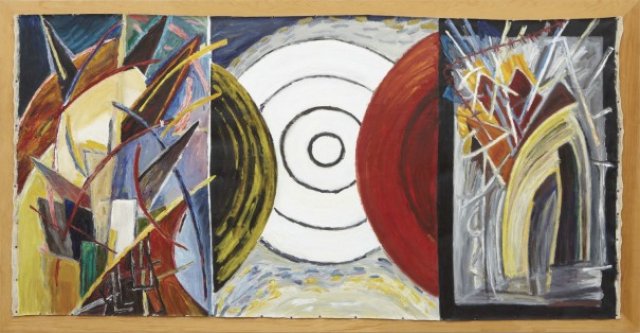Artist Katherine Porter Broke Out in Boston
A Posthumous Interview
By: Charles Giuliano - Jul 11, 2024
During the social unrest of the late 1960s, Katherine Porter was a force in an emerging generation of
Katherine Louanne Pavlis was born on Sept. 11, 1941, in
She broke out in
We kept in touch by e mail and she sent comments on my articles. She was quite happy when last I heard from her. .
Charles Giuliano: When did you arrive in
Katherine Porter In 1967 on the eve of separation from my husband. I was born in
CG You worked with Jonathan Kozol. ( Kozol born September 5, 1936 is an American writer, progressive activist, and educator, best known for his books on public education in the United States.)
KP I was volunteering at Harriet Tubman House (
CG What were the projects?
KP Self portraits, pictures of their families. I loved it. I absolutely loved it. They were funny and irreverent. That was my life at the time. I worked for Avatar (the Lyman family paper).
CG What did you do?
KP I helped with layout but it wasn’t very regular. That’s where I met John Chandler. He was also involved with the school. As everyone knows what Jonathan did was involve the parents. It was the parents and Jonathan that started the
CG What was your work like?
KP I was painting and happy about it. I was doing grid based things. I don’t think any of them got saved. The subject was
I had a great teacher at BU, Conger Metcalf.
(Conger Metcalf , 1914-1998, was born in
And Walter Murch (born and grew up in
I was only there for one semester then left for
CG Lets talk about the Studio Coalition which you were part of. Was it 1968 or 1969?
KP Michael Phillips instigated that. He’s making 30’ long paintings in
CG His brother Frank was a photographer. What do you recall?
KP We were all young and pretty. We had all tried to get into
We decided to open our studios. We had meetings and everyone was very serious.
CG As far as I know that was
KP It was pretty much in one neighborhood. Bill and Michael had studios on
CG I had just started writing a column Art Bag for Boston After Dark/
KP You have to say something to make it interesting to people. I was making prints during Open Studios and didn’t have to talk to people when they came around. They got to see an artist at work.
CG Did you show at Gallery 11 at Tufts?
KP No.
CG A lot of people showed there.
KP Did Todd (Mckee)?
CG No, he wasn’t a part of that. The Smart Duckys came later and showed together in a loft on
At that time the best gallery for contemporary art on
KP Phyllis was my best friend. Three If By Air was such a nice thing to be part of. For me that was the start of a big and important adventure. It was a big deal showing in that gallery with two of my friends. John wrote about it and you did. It was a big deal. Phyllis was wonderful. She was unconventional, enthusiastic.
CG She was unique for that era.
KP The older artists were conservative except Hyman Bloom. Hyman Swetsoff had a really great gallery. I lived with his wife Sarah (Swetsoff).
(He was murdered in 1968. At the time he showed Hyman Bloom, and the young conceptual artist Bruce Conner who was doing acid with Tim Leary and Richard Alpert in
I took care of their children and lived with them as part of a deal brokered by Conger Metcalf when I was at BU.
CG It’s interesting to talk about Bloom. During an opening at the MFA I interviewed Ellsworth Kelly who told us that he had studied with (Boston Expressionist ) Karl Zerbe at the
KP So do I. They were important to me and my generation.
CG It’s significant to hear you say that. It shows generosity in being able to look at work that is not like your own.
KP I like any good art. A friend just wrote me a beautiful letter about Constable.
(John Constable– born 1776, East Bergholt,
It’s romanticism and you have to look at the paintings. I think we’re in a dismal period right now.
CG As a contemporary artist you’re a part of that equation.
KP I’m not.
CG Were you part of Parker 470?
(An industrial space on
KP I would not have a career without Joan Sonnabend. I owe her everything. Through her and Phyllis I was connected to Wayne Andersen who showed me at MIT (Hayden Gallery). It was a big show and quite beautiful Charles.
CG You left
KP I got a grant, an NEA, which was partly through the connections of Phyllis. They needed to find a woman from
CG We are phasing out of
KP I loved those years. The people that I met in the South End, (black artists) Dana Chandler,Jr., Gary Rickson, Roy Cato, Jr, and the kid, Winston C. Robinson.
CG Didn’t Winston show with you during Open Studios?
(Winston was much loved and played occasionally with the punk band The Rentals fronted by Jeff and Jane Hudson. She recently told me that Winston passed several years ago.)
Were you ever in the Whitney Annual (later Biennial)?
KP Yes, twice. One was the result of the Studio Coalition because (curator) Marcia Tucker came. That was 1972 and there was another one. Then, according to them, I dropped dead.
CG You seem very much alive. It’s funny but what do you mean by that?
KP They were no longer interested in looking at my work.
I met John Chandler and their seven children. I baby sat for them when they stayed in
CG Of that generation you were the singular success story in terms of galleries and museums.
KP It was gratifying for the attention I was getting. It was also very hard. Like a lot of women you think I don’t deserve it in some way. I was glad to get out of
CG Speaking of camaraderie what did the Studio Coalition mean to you?
KP We were a bunch of friends who hung out. I talked a lot with Michael Phillips. He and Curtis Crystal were a serious team.
CG Where does Drew Hyde come into all this?
(Hyde was the
KP We all loved Drew. The
CG The former Con Ed building became the Act Now Workshop. There was a rumor that Drew had a rocket stored there.
KP It was a great place for kids to work in with exhibitions and parties.
CG That was when they were promoting Pernod which flowed freely during parties. At one of those gatherings Drew performed a pratfall tumbling down stairs then laughing when we were shocked. There was a mad side to him. The architect Edwin Child was involved.
KP They were creating small parks in the South End and Roxbury.
CG Did you ever paint a mural?
KP Yes, in the South End. Gary Rickson and I shared a wall.
CG It seems that when the
KP I loved Drew and he did so much because he was unprofessional. He showed good art but his main focus was on community activism.
CG You might say the same of the
KP Even before that Karl was a friend who came to openings and parties. He wrote a book on rock ‘n’ roll. Even when he was teaching at Brandeis he was a friend of
CG When you left
KP I was painting and teaching.
CG How were you surviving? Did you get any assistance?
KP No, my family didn’t believe in that which was so helpful because I learned to be independent. I was very lucky in
(She had solo exhibitions at the Knoedler Gallery in
CG That ended.
KP Things change. (The McKee gallery closed in 2015.) I loved being in
CG Were you involved with Skowhegan School of Art?
KP I taught there and did lectures. I loved the directors. I was connected a little bit but not professionally. I have had a teaching career until 2002. I taught everywhere, at every level, from preschool to graduate school, Stanford,
CG Is there any particular period or body of work that you feel is especially important?
KP I would say the
(With Stephen Porter they traveled to South America, spending time in the Galapagos Islands,
CG On the one hand you are an abstract artist and yet you are an activist with social and political issues. How do you resolve that?
KP The
CG How do you get that into a painting?
KP Conceptually, I tried to do it abstractly. There was barbed wire. A circle became the sun. It was natural and more or less basic.
CG How were the works received?
KP Well.
CG Did collectors comprehend what they entailed?
KP I don’t know. KcKee did I’m sure.
CG Are any of those paintings in museums?
KP Yes, a lot of them.
CG Are any museums talking to you about shows?
KP No. I had one at South Carolina Museum of Art in 2008. It was collaboration with women writers.
CG Are you currently involved with any political movements?
KP No, much to my shame. I don’t have the stamina to do any serious volunteer work. Every day I want to call Bernie Sanders and say “put me to work.”
CG Are you content with
KP I love it. I don’t want to move again, so far. Although, I keep moving.
CG What brought you here?
KP I was in the
CG Visiting your house was fascinating and definitely conveyed your style. We were impressed that you have hauled around such huge furniture items. It seemed that you spend a lot of time reading and listening to music. What are you reading?
KP I just finished Thoreau and (Jacob) Burckhardt on the Renaissaance. I was reading Machiavelli and the Borgias. It was interesting but so boring that I jumped to Burckhardt.
CG Do you have plans to travel in
KP I have dreams of
CG The
KP It wasn’t just the MFA. That was a small part of it. There was an academic attitude which is still there.
CG Were you involved in any of Drew’s projects with the
KP I was there all the time. At the (South End) Electric Plant I ran workshops there, There was a big space for children. He got an art supply store to donate materials. Polaroid gave us cameras. Everybody gave us materials.
CG I co-curated an exhibition of contemporary realism Images for the City Hall Gallery. Drew showed me a closet there packed with Polaroid cameras.
KP The South End building had the Act Now Workshop.
CG Did the kids learn anything?
KP They had fun when they were there.
CG I recall a large exhibition in that space. Crossing the crowded gallery during the opening I crashed into a freestanding, plexiglass sculpture by Tony Thompson. It was very embarrassing and of course there were jokes about the blind art critic. His work was ephemeral and at times damaged during exhibitions. Tony told me that he got more money from insurance claims than sales.
KP There were kids I became close to. The father of Michael was an alcoholic and his mother had passed. I spent a lot of time with him and other kids. A couple of years ago I ran into him panhandling. We were reaching out to broken and damaged kids.
CG You are upset.
KP Yes, because kids like Michael didn’t have a chance. He dropped out of school early on.
CG That describes a lot of kids you worked with.
What’s driving your work now?
KP I don’t know I just like working in the studio every day. It’s very intuitive. In the studio I listen to classical music all the time. I used to listen to rock ‘n’ roll but classical music has come to be a joy in my life. I go to every concert I can.
CG Do you know about music?
KP I know a lot about music. By listening for forty years and reading everything I can get my hands on.
CG Getting back to Drew and the
KP He was very diligent in creating a list of who to include. I remember black artists like Dana Chandler, Jr. and Gary Rickson. There were the Studio Coalition artists Andy, Michael, Liz, Tony, Bill, me. It was very comprehensive as well as having the recognition and endorsement of the City. People would do anything for Drew.
CG It was significant that he integrated black artists into the
Did you interact with Portia Harcus (gallerist)?
KP We were friends and I showed with her. I liked Portia and Barbara but my loyalty was to Phyllis and Joan.
CG Did you view yourself as a feminist?
KP Not really though I was all for it but I wasn’t a member of a feminist group. My friends were mostly women. I didn’t have issues because I’m not in academia. I didn’t encounter resistance. My career was amazing and I am happy about that. I have no feelings of being excluded in any way. I know there’s a boy’s club but that’s not my fight.
CG What is your fight?
KP To get our country to behave.
CG You have a short fuse.
KP I do about social issues. It’s not supposed to be this way. We are a democracy and compassionate.
CG Is it difficult to find people of like mind?
KP Well, if I lived in Williamstown. It was not an issue in

